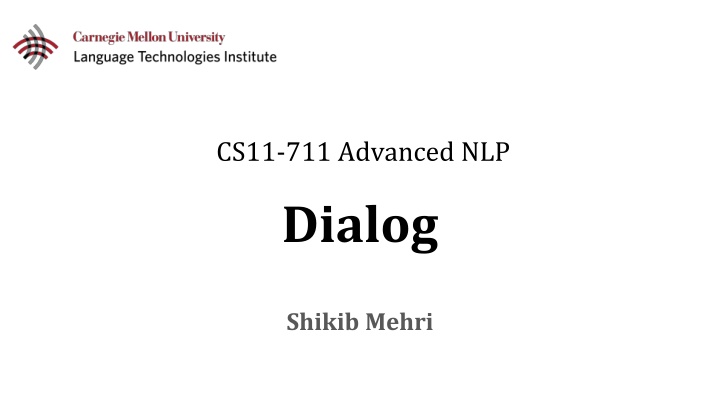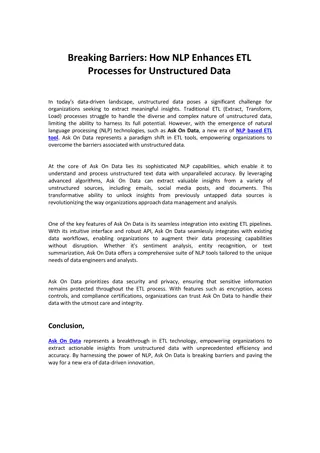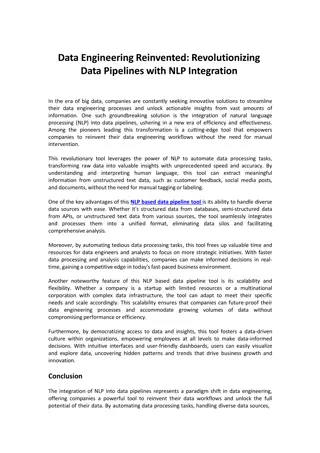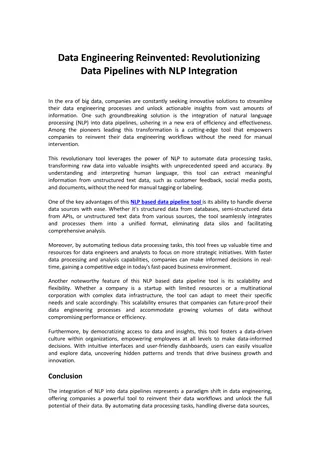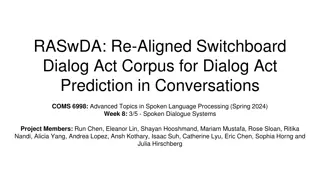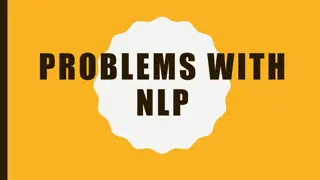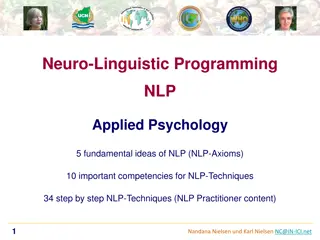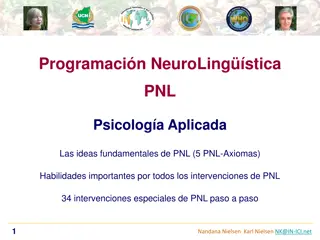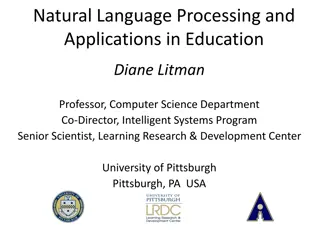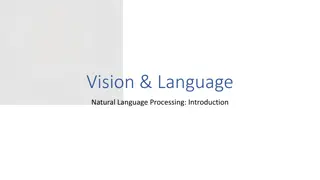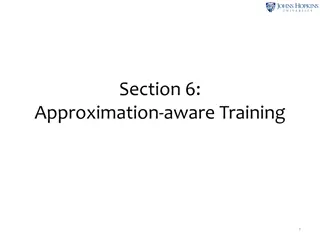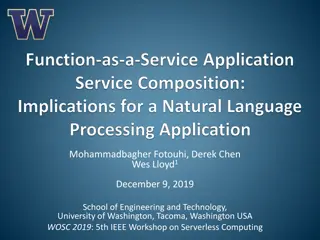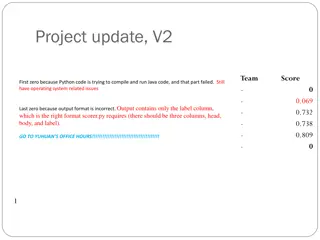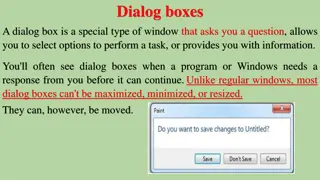Delving into Advanced NLP for Dialog Systems
Explore the realm of advanced Natural Language Processing (NLP) for dialog systems, focusing on generating coherent responses, understanding dialog histories, tackling new challenges in dialog context modeling, and mastering tasks like response generation and dialog evaluation. Gain insights into unique challenges, common tasks/datasets, and prevalent models/strategies in dialog research.
Download Presentation

Please find below an Image/Link to download the presentation.
The content on the website is provided AS IS for your information and personal use only. It may not be sold, licensed, or shared on other websites without obtaining consent from the author.If you encounter any issues during the download, it is possible that the publisher has removed the file from their server.
You are allowed to download the files provided on this website for personal or commercial use, subject to the condition that they are used lawfully. All files are the property of their respective owners.
The content on the website is provided AS IS for your information and personal use only. It may not be sold, licensed, or shared on other websites without obtaining consent from the author.
E N D
Presentation Transcript
CS11-711 Advanced NLP Dialog Shikib Mehri
What is dialog? NLP for conversations Understanding utterances, in the context of a conversation Generating responses That are consistent and coherent with the dialog history That are interesting and engaging That meaningfully progress the dialog towards a goal 2
What is NEW in dialog? The dialog history Consider an utterance in the context of the dialog history Must understand back-and-forth interaction, estimate belief state over user goals, resolve co-references, etc. The goal/purpose of the conversation: Task-oriented: progress dialog towards some goal/complete a task Open-domain: produce interesting/engaging responses 3
What is NEW in dialog? New challenges: modelling dialog context, goal-driven nature, task-specific terminology, one-to-many response problem in open-domain New tasks: response generation (task-oriented vs open-domain), NLU (intent prediction, slot filling, state tracking), NLG (structured data response generation), dialog evaluation New models 4
Objective My objective in this lecture is for you to walk away with: Knowledge of the unique challenges in dialog research Knowledge of the tasks/datasets that are commonly studied in dialog Knowledge of the common models/strategies used in dialog 5
Outline Response generation Task-oriented Open-domain NLU (intent prediction, slot filling, state tracking) Dialog evaluation 6
Response Generation User: Hello System: Hello, how are you today? User: I m fine. I m watching Netflix System: What are you watching? I just finished Squid Game. User: I m watching the new season of You. It s really good! System: What s it about? I need something new to watch. Model 7
Response Generation User: Hello System: Hello, how may I help you? User: Find me a good italian restaurant System: Okay, what neighbourhood are you in? User: Oakland System: Okay, I found Lucca, an Italian restaurant in Oakland. Model 8
Response Generation User: Hello System: Hello, how may I help you? User: Find me a good italian restaurant System: Okay, what neighbourhood are you in? User: Oakland User: Oakland User: Hello System: Hello, how may I help you? User: Find me a good italian restaurant System: Okay, what neighbourhood are you in? System: Okay, I found Lucca, an Italian restaurant in Oakland. Italian restaurant in Oakland. System: Okay, I found Lucca, an Model Model Database 9
Task-Oriented Response Generation Task-oriented dialog systems interact with a user in order to complete a specific task. MultiWOZ [Budzianowski et al. 2018] SGD [Rastogi et al. 2019] STAR [Mosig et al. 2020] Taskmaster-2 [Byrne et al. 2020] ABCD [Chen et al. 2021] 10
Task-Oriented Response Generation Task-oriented dialog systems interact with a user in order to complete a specific task. Must understand the dialog context Must track belief state over dialog context Often need to interpret structured database output Must follow task-specific dialog policy Must generate natural language responses 11
Task-Oriented Response Generation Task-oriented dialog systems interact with a user in order to complete a specific task. Must understand the dialog context Must track belief state over dialog context Often need to interpret structured database output Must follow task-specific dialog policy Must generate natural language responses 13
Dialog Modules Start with pre-trained neural dialog modules 16
Open-Domain Response Generation Open-domain dialog systems must engage in chit-chat with a user DailyDialog [Li et al. 2017] PersonaChat [Zhang et al. 2018] Topical-Chat [Gopalakrishnan et al. 2019] Wizards of Wikipedia [Dinan et al. 2018] Empathetic Dialogs [Rashkin et al. 2019] 21
Open-Domain Response Generation Open-domain dialog systems must engage in chit-chat with a user Must understand the dialog context Must be able to discuss a variety of topics Must generate natural language responses Must generate engaging/interesting responses Must demonstrate common sense reasoning 22
Diversity Promoting Objective [Li et al. 2016] To mitigate the dull response problem ( I don t know ), Li et al. proposes a diversity-promoting objective function Use MMI rather than cross entropy as a loss function Penalize high-likelihood responses (anti LM objective) 25
Persona-Conditioned Models [Zhang et al. 2018] To make open-domain chit-chat dialog models more consistent and engaging, condition them on a persona 27
DialoGPT [Zhang et al. 2019] Continue pre-training GPT-2 on conversations from Reddit Filter long utterances Filter non-English utterances Filter URLs Filter toxic comments Train on 147M dialog instances (1.8B words) Human-level response generation ability 30
Open-Domain Response Generation Knowledge-grounded response generation Persona-grounded response generation Negotiation/persuasive dialog Commonsense dialog Conversational QA 35
NLU Natural language understanding in dialog involves several key tasks: Intent prediction: what is the user s intent/goal Slot filling: what are the slot values (e.g., what is the time) State tracking: track user information/goals throughout the dialog 36
NLU Natural language understanding in dialog involves several key tasks: DialoGLUE [Mehri et al. 2020] Intent prediction: ATIS, SNIPS, Banking77, CLINC150, HWU64 Slot filling: ATIS, SNIPS, DSTC8-SGD, Restaurant8k State tracking: MultiWOZ (2.X) 37
ConVEx [Henderson and Vulic. 2020] Pre-training paradigm specifically for slot filling strong few-shot/zero-shot performance 38
Results on Restaurant8k Fraction Span-BERT ConVEx GenSF 1 (8198) 93.1 96.0 96.1 1/2 (4099) 91.4 94.1 94.3 1/4 (2049) 88.0 92.6 93.2 1/16 (512) 76.6 86.4 89.7 1/128 (64) 30.6 71.7 72.2 40
Zero-Shot Slot Filling Slot Coach + TR ConVEx GenSF First Name 2.5 4.1 19.8 Last Name 0.0 3.4 13.8 Date 15.7 3.6 12.6 Time 35.1 9.1 34.7 Number of People 0 6.0 16.4 Average 10.7 5.2 19.5 41
Dialog Evaluation Goal: Construct automatic evaluation metrics for response generation/interactive dialog Given: dialog history, generated response, reference response (optional) Output: a score for the response 44
Why is evaluating dialog hard? (1/3) 1. One-to-many nature of dialog Hello! For each dialog there are many valid responses Hey there! Cannot compare to a reference response Good morning! The reference response isn t the only valid response How are you? Existing metrics won t work BLEU, F-1, etc. 45
Why is evaluating dialog hard? (2/3) 2. Dialog quality is multi-faceted A response isn t just good or bad For interpretability, should measure multiple qualities Relevance Interestingness Fluency 46
Why is evaluating dialog hard? (3/3) 3. Dialog is inherently interactive Dialog systems are designed to have a back-and-forth interaction with a user Research largely focuses on static corpora Reduces the problem of dialog to response generation Some properties of a system can t be assessed outside an interactive environment Long-term planning, error recovery, coherence. 47
Dialog Evaluation Evaluation of dialog is hard Can t compare to a reference response [no BLEU, F-1, etc.] Should assess many aspects of dialog quality [relevant, interesting, etc.] Should evaluate in an interactive manner 48
Dialog Evaluation USR [Mehri and Eskenazi. 2020] GRADE [Huang et al. 2020] HolisticEval [Pang et al. 2020] If you re interested in dialog evaluation. Check out our repository and paper: DSTC6 [Hori and Hori. 2017] FED [Mehri and Eskenazi. 2020] https://github.com/exe1023/DialEvalMetrics A Comprehensive Assessment of Dialog Evaluation Metrics Yi-Ting Yeh, Maxine Eskenazi, Shikib Mehri DSTC9 [Gunasekara et al. 2021] 49
